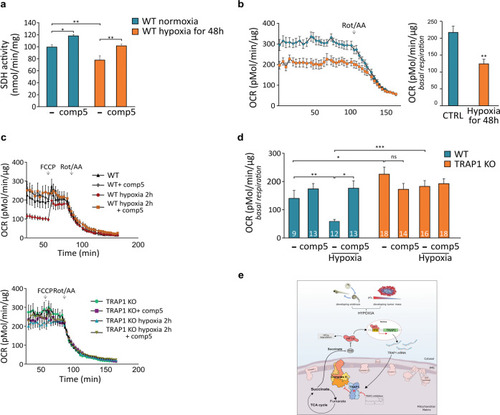|
TRAP1 inhibits respiration under hypoxia.a Spectrophotometric measurements of SDH activity on wild-type Zebrafish embryos kept in normoxia or hypoxia (5% O2) for 48 h. Where indicated, embryos were treated with the specific TRAP1 inhibitor compound 5 (100 μM, 2 h). b Assessment of oxygen consumption rate (OCR) in wild-type embryos at 96 hpf, either untreated (blue line and bar) or exposed to hypoxia for 48 h (orange line and bar). Respiratory complex I and III inhibitors (2 μM rotenone and 5 μM antimycin A, respectively) were added where indicated. c, d OCR measurements in TRAP1 wild-type and knock-out living Zebrafish embryos, either kept in normoxic condition or after 2 h of exposure to hypoxia (5% O2). Subsequent additions of the proton uncoupler carbonyl cyanide-4-(trifluoromethoxy)phenylhydrazone (FCCP, 0.5 μM) and of the respiratory complex I and III inhibitors (2 μM rotenone and 5 μM antimycin A, respectively) were carried out as indicated. The specific TRAP1 inhibitor compound 5 (100 μM) was added in fish water 4 h prior to OCR analysis. In fish exposed to hypoxia, the drug was added 2 h before hypoxic treatment and maintained throughout hypoxia exposure. The number of animals used for each condition is reported inside column bars. e Schematic representation of the feed-forward crosstalk between HIF1α and TRAP1. In (a–d), data are reported as average ±SEM with one-way ANOVA and Bonferroni’s correction of four independent experiments (a, c, d), or at least 20 animals per condition (b) with an unpaired two-tailed Student’s t test. Asterisks indicate significant differences (*p < 0.05, ∗∗p < 0.01, ***p < 0.001).
|

